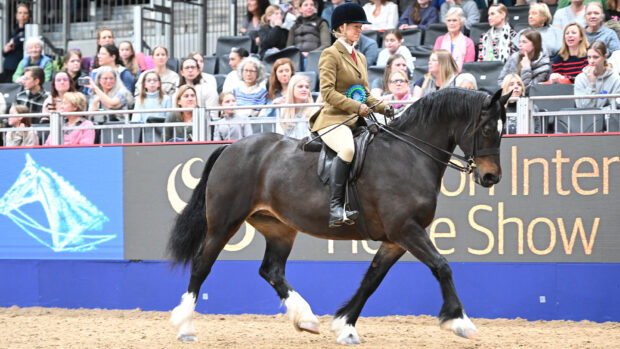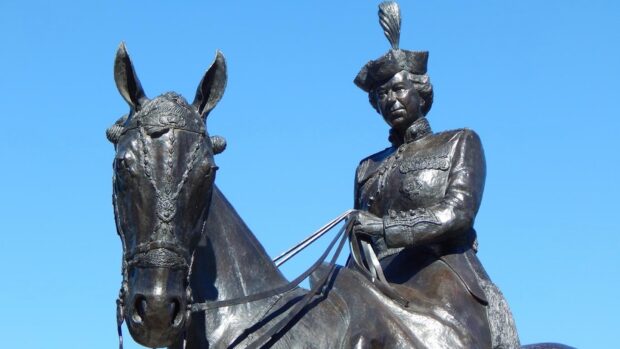“I’m very lucky,” says Lottie Fry . She moved to the Netherlands in 2014 to train with the van Olsts and has lived there ever since. Anne van Olst is a five-time Olympian and Lottie’s trainer and mentor, and the operation focuses on stallions at stud, dressage, training, youngstock and buying and selling horses. Lottie’s good fortune is in the horses she rides.
She explains that Anne’s husband, Gertjan van Olst, “is breeding horses all the time, and always trying to improve”. There are currently 27 much-garlanded stallions on the Van Olst site including household names such as Everdale and Glamourdale .
Lottie adds: “One of the top attributes that Gertjan’s looking for is good character. It’s very important, right from the beginning, especially for stallions, because they need to balance the breeding and the sport – and it’s very difficult unless they have good character.”
Lottie Fry rides Nalegro in the Dressage Unwrapped demo at the 2022 London International, while her trainer Anne van Olst (left) and commentator Lee McKenzie look on. Credit: Peter Nixon
What exactly is “good character”? It means “they love their job”, Lottie explains. “I love it when you get on a horse and they want to please and want to do the job for you. It makes my job easier! They’re very easy to train, and the breeding offspring we have are so talented as young horses.”
{"content":"PHA+4oCcSXTigJlzIHZlcnkgaW1wb3J0YW50IHRvIHRha2UgZXZlcnkgaG9yc2UgYXMgYW4gaW5kaXZpZHVhbCwgdGhleeKAmXJlIGFsbCBzbGlnaHRseSBkaWZmZXJlbnQsIHRoZXJlIHdpbGwgbmV2ZXIgYmUgdHdvIHRoZSBzYW1lLCBzbyB3ZSBrZWVwIGFuIG9wZW4gbWluZCBhbmQgdHJhaW4gdGhlbSBlYWNoIGFzIHRoZXkgbmVlZCB0byBiZSB0cmFpbmVkLiBTb21lIHRha2UgbG9uZ2VyLCB3ZSBnbyBhdCB0aGVpciBzcGVlZCzigJ0gYWRkcyBMb3R0aWUuPC9wPgo8ZGl2IGlkPSJhdHRhY2htZW50Xzc5NzQwOSIgc3R5bGU9IndpZHRoOiAxNDExcHgiIGNsYXNzPSJ3cC1jYXB0aW9uIGFsaWdubm9uZSI+PGltZyBmZXRjaHByaW9yaXR5PSJoaWdoIiBkZWNvZGluZz0iYXN5bmMiIGFyaWEtZGVzY3JpYmVkYnk9ImNhcHRpb24tYXR0YWNobWVudC03OTc0MDkiIGNsYXNzPSJsYXp5bG9hZCBibHVyLXVwIHNpemUtZnVsbCB3cC1pbWFnZS03OTc0MDkiIGRhdGEtcHJvY2Vzc2VkIHNyYz0iaHR0cHM6Ly9rZXlhc3NldHMudGltZWluY3VrLm5ldC9pbnNwaXJld3AvbGl2ZS93cC1jb250ZW50L3VwbG9hZHMvc2l0ZXMvMTQvMjAxNy8wMy9uZXctaGgtcGxhY2Vob2xkZXItMjAweDIwMC5wbmciIGRhdGEtc3JjPSJodHRwczovL2tleWFzc2V0cy50aW1laW5jdWsubmV0L2luc3BpcmV3cC9saXZlL3dwLWNvbnRlbnQvdXBsb2Fkcy9zaXRlcy8xNC8yMDIyLzA4L0NoYXJsb3R0ZUZSWV9HbGFtb3VyZGFsZV9XQ0hlcl9QTjIyXzMxNDQ1LmpwZyIgYWx0PSJMb3R0aWUgRnJ5IGFuZCBHbGFtb3VyZGFsZSBkdXJpbmcgdHJhaW5pbmcgYXQgdGhlIDIwMjIgV29ybGQgRHJlc3NhZ2UgQ2hhbXBpb25zaGlwcyIgd2lkdGg9IjE0MDEiIGhlaWdodD0iNzg4IiBkYXRhLXNpemVzPSJhdXRvIiBkYXRhLXNyY3NldD0iaHR0cHM6Ly9rZXlhc3NldHMudGltZWluY3VrLm5ldC9pbnNwaXJld3AvbGl2ZS93cC1jb250ZW50L3VwbG9hZHMvc2l0ZXMvMTQvMjAyMi8wOC9DaGFybG90dGVGUllfR2xhbW91cmRhbGVfV0NIZXJfUE4yMl8zMTQ0NS5qcGcgMTQwMXcsIGh0dHBzOi8va2V5YXNzZXRzLnRpbWVpbmN1ay5uZXQvaW5zcGlyZXdwL2xpdmUvd3AtY29udGVudC91cGxvYWRzL3NpdGVzLzE0LzIwMjIvMDgvQ2hhcmxvdHRlRlJZX0dsYW1vdXJkYWxlX1dDSGVyX1BOMjJfMzE0NDUtMzAweDE2OS5qcGcgMzAwdywgaHR0cHM6Ly9rZXlhc3NldHMudGltZWluY3VrLm5ldC9pbnNwaXJld3AvbGl2ZS93cC1jb250ZW50L3VwbG9hZHMvc2l0ZXMvMTQvMjAyMi8wOC9DaGFybG90dGVGUllfR2xhbW91cmRhbGVfV0NIZXJfUE4yMl8zMTQ0NS02MzB4MzU0LmpwZyA2MzB3LCBodHRwczovL2tleWFzc2V0cy50aW1laW5jdWsubmV0L2luc3BpcmV3cC9saXZlL3dwLWNvbnRlbnQvdXBsb2Fkcy9zaXRlcy8xNC8yMDIyLzA4L0NoYXJsb3R0ZUZSWV9HbGFtb3VyZGFsZV9XQ0hlcl9QTjIyXzMxNDQ1LTEzNXg3Ni5qcGcgMTM1dywgaHR0cHM6Ly9rZXlhc3NldHMudGltZWluY3VrLm5ldC9pbnNwaXJld3AvbGl2ZS93cC1jb250ZW50L3VwbG9hZHMvc2l0ZXMvMTQvMjAyMi8wOC9DaGFybG90dGVGUllfR2xhbW91cmRhbGVfV0NIZXJfUE4yMl8zMTQ0NS0zMjB4MTgwLmpwZyAzMjB3LCBodHRwczovL2tleWFzc2V0cy50aW1laW5jdWsubmV0L2luc3BpcmV3cC9saXZlL3dwLWNvbnRlbnQvdXBsb2Fkcy9zaXRlcy8xNC8yMDIyLzA4L0NoYXJsb3R0ZUZSWV9HbGFtb3VyZGFsZV9XQ0hlcl9QTjIyXzMxNDQ1LTYyMHgzNDkuanBnIDYyMHcsIGh0dHBzOi8va2V5YXNzZXRzLnRpbWVpbmN1ay5uZXQvaW5zcGlyZXdwL2xpdmUvd3AtY29udGVudC91cGxvYWRzL3NpdGVzLzE0LzIwMjIvMDgvQ2hhcmxvdHRlRlJZX0dsYW1vdXJkYWxlX1dDSGVyX1BOMjJfMzE0NDUtOTIweDUxNy5qcGcgOTIwdywgaHR0cHM6Ly9rZXlhc3NldHMudGltZWluY3VrLm5ldC9pbnNwaXJld3AvbGl2ZS93cC1jb250ZW50L3VwbG9hZHMvc2l0ZXMvMTQvMjAyMi8wOC9DaGFybG90dGVGUllfR2xhbW91cmRhbGVfV0NIZXJfUE4yMl8zMTQ0NS0xMjIweDY4Ni5qcGcgMTIyMHciIHNpemVzPSIobWF4LXdpZHRoOiAxNDAxcHgpIDEwMHZ3LCAxNDAxcHgiIC8+PHAgaWQ9ImNhcHRpb24tYXR0YWNobWVudC03OTc0MDkiIGNsYXNzPSJ3cC1jYXB0aW9uLXRleHQiPkxvdHRpZSBGcnkgYW5kIEdsYW1vdXJkYWxlIHdpdGggdGhlIHZhbiBPbHN0cyBkdXJpbmcgYSB0cmFpbmluZyBzZXNzaW9uIGF0IHRoZSAyMDIyIFdvcmxkIERyZXNzYWdlIENoYW1waW9uc2hpcHMuIENyZWRpdDogUGV0ZXIgTml4b248L3A+PC9kaXY+CjxwPlRoYXQgZ29vZCBjaGFyYWN0ZXIgaGFzIHRvIGluY2x1ZGUgYSBjZXJ0YWluIHN0YWdlLWNyYWZ0IHRvIHBlcmZvcm0gd2VsbCBpbiBkcmVzc2FnZSwgdGhleSBuZWVkIHRvIOKAnGhhdmUgdGhhdCBzaG93bWFuc2hpcDsgdGhlIHN0YWxsaW9uIHNpZGUgbWFrZXMgaXQgdmVyeSBleGNpdGluZ+KAnS48L3A+Cgo8aDI+Tm8gc2hvcnRjdXRzIHRvIGJ1aWxkaW5nIGEgcGFydG5lcnNoaXA8L2gyPgo8cD5JdOKAmXMgZXNzZW50aWFsIHRvIGJlIGF0dGVudGl2ZSB0byB0aGVpciBjaGFyYWN0ZXJzIGZyb20gdGhlIGJlZ2lubmluZywgTG90dGllIHNheXM6IOKAnE9uY2UgeW91IHN0YXJ0IHRvIHdvcmssIHlvdSBzZWUgaG93IHRoZSBob3JzZXMgcmVhY3Qgb24gdGhlIGdyb3VuZCBhcm91bmQgeW91LCBob3cgdGhleSBhcmUgaW4gdGhlIHN0YWJsZSwgaWYgdGhleeKAmXJlIG5lcnZvdXMgb3IgY29uZmlkZW50IGFuZCB5b3UgYnVpbGQgdGhlbSB1cCB0byBjcmVhdGUgYSBwYXJ0bmVyc2hpcC4gVGhlIGJldHRlciB0aGV5IGtub3cgeW91IGFuZCB5b3Uga25vdyB0aGVtLCB0aGUgbW9yZSBsaWtlbHkgaXTigJlzIGdvaW5nIHRvIGdvIHdlbGwu4oCdPC9wPgo8cD5UaGVyZeKAmXMgbm8gc2hvcnRjdXQgdG8gYnVpbGRpbmcgcmFwcG9ydCwgTG90dGllIHBvaW50cyBvdXQ6IOKAnEl0IGNvbWVzIHdpdGggdGltZSwgaXTigJlzIHRoZSBzYW1lIGFzIGh1bWFucywgc29tZSB0cnVzdCBhIGxvdCBlYXNpZXIgdGhhbiBvdGhlcnMsIGJ1dCB3aGVuIHlvdSBnYWluIHRoZSB0cnVzdCwgdGhleeKAmWxsIGRvIGFueXRoaW5nIGZvciB5b3Uu4oCdPC9wPgoKPGRpdiBpZD0iYXR0YWNobWVudF83MDgzMDciIHN0eWxlPSJ3aWR0aDogMTQxMHB4IiBjbGFzcz0id3AtY2FwdGlvbiBhbGlnbm5vbmUiPjxpbWcgZGVjb2Rpbmc9ImFzeW5jIiBhcmlhLWRlc2NyaWJlZGJ5PSJjYXB0aW9uLWF0dGFjaG1lbnQtNzA4MzA3IiBjbGFzcz0ibGF6eWxvYWQgYmx1ci11cCBzaXplLWZ1bGwgd3AtaW1hZ2UtNzA4MzA3IiBkYXRhLXByb2Nlc3NlZCBzcmM9Imh0dHBzOi8va2V5YXNzZXRzLnRpbWVpbmN1ay5uZXQvaW5zcGlyZXdwL2xpdmUvd3AtY29udGVudC91cGxvYWRzL3NpdGVzLzE0LzIwMTcvMDMvbmV3LWhoLXBsYWNlaG9sZGVyLTIwMHgyMDAucG5nIiBkYXRhLXNyYz0iaHR0cHM6Ly9rZXlhc3NldHMudGltZWluY3VrLm5ldC9pbnNwaXJld3AvbGl2ZS93cC1jb250ZW50L3VwbG9hZHMvc2l0ZXMvMTQvMjAyMC8wMi9EU0MzNTU2XzM3MTEyMjIyMV82MzI3NjQ5NDIuanBnIiBhbHQ9IkxvdHRpZSBGcnkgd2l0aCBoZXIgV29ybGQgQ2hhbXBpb25zaGlwcyByaWRlIEdsYW1vdXJkYWxlLiIgd2lkdGg9IjE0MDAiIGhlaWdodD0iNzg4IiBkYXRhLXNpemVzPSJhdXRvIiBkYXRhLXNyY3NldD0iaHR0cHM6Ly9rZXlhc3NldHMudGltZWluY3VrLm5ldC9pbnNwaXJld3AvbGl2ZS93cC1jb250ZW50L3VwbG9hZHMvc2l0ZXMvMTQvMjAyMC8wMi9EU0MzNTU2XzM3MTEyMjIyMV82MzI3NjQ5NDIuanBnIDE0MDB3LCBodHRwczovL2tleWFzc2V0cy50aW1laW5jdWsubmV0L2luc3BpcmV3cC9saXZlL3dwLWNvbnRlbnQvdXBsb2Fkcy9zaXRlcy8xNC8yMDIwLzAyL0RTQzM1NTZfMzcxMTIyMjIxXzYzMjc2NDk0Mi0zMDB4MTY5LmpwZyAzMDB3LCBodHRwczovL2tleWFzc2V0cy50aW1laW5jdWsubmV0L2luc3BpcmV3cC9saXZlL3dwLWNvbnRlbnQvdXBsb2Fkcy9zaXRlcy8xNC8yMDIwLzAyL0RTQzM1NTZfMzcxMTIyMjIxXzYzMjc2NDk0Mi02MzB4MzU1LmpwZyA2MzB3LCBodHRwczovL2tleWFzc2V0cy50aW1laW5jdWsubmV0L2luc3BpcmV3cC9saXZlL3dwLWNvbnRlbnQvdXBsb2Fkcy9zaXRlcy8xNC8yMDIwLzAyL0RTQzM1NTZfMzcxMTIyMjIxXzYzMjc2NDk0Mi0xMzV4NzYuanBnIDEzNXcsIGh0dHBzOi8va2V5YXNzZXRzLnRpbWVpbmN1ay5uZXQvaW5zcGlyZXdwL2xpdmUvd3AtY29udGVudC91cGxvYWRzL3NpdGVzLzE0LzIwMjAvMDIvRFNDMzU1Nl8zNzExMjIyMjFfNjMyNzY0OTQyLTMyMHgxODAuanBnIDMyMHcsIGh0dHBzOi8va2V5YXNzZXRzLnRpbWVpbmN1ay5uZXQvaW5zcGlyZXdwL2xpdmUvd3AtY29udGVudC91cGxvYWRzL3NpdGVzLzE0LzIwMjAvMDIvRFNDMzU1Nl8zNzExMjIyMjFfNjMyNzY0OTQyLTYyMHgzNDkuanBnIDYyMHcsIGh0dHBzOi8va2V5YXNzZXRzLnRpbWVpbmN1ay5uZXQvaW5zcGlyZXdwL2xpdmUvd3AtY29udGVudC91cGxvYWRzL3NpdGVzLzE0LzIwMjAvMDIvRFNDMzU1Nl8zNzExMjIyMjFfNjMyNzY0OTQyLTkyMHg1MTguanBnIDkyMHcsIGh0dHBzOi8va2V5YXNzZXRzLnRpbWVpbmN1ay5uZXQvaW5zcGlyZXdwL2xpdmUvd3AtY29udGVudC91cGxvYWRzL3NpdGVzLzE0LzIwMjAvMDIvRFNDMzU1Nl8zNzExMjIyMjFfNjMyNzY0OTQyLTEyMjB4Njg3LmpwZyAxMjIwdyIgc2l6ZXM9IihtYXgtd2lkdGg6IDE0MDBweCkgMTAwdncsIDE0MDBweCIgLz48cCBpZD0iY2FwdGlvbi1hdHRhY2htZW50LTcwODMwNyIgY2xhc3M9IndwLWNhcHRpb24tdGV4dCI+TG90dGllIEZyeSBhdCBob21lIHdpdGggR2xhbW91cmRhbGUgYXQgdGhlIHZhbiBPbHN0c+KAmSBzdGFibGVzLiBDcmVkaXQ6IExpeiBOZXZpbGxlIFBob3RvZ3JhcGh5PC9wPjwvZGl2Pgo8cD5DYXNlIGluIHBvaW50IGlzIEdsYW1vdXJkYWxlLCBMb3R0aWXigJlzIE9seW1waWMgdGVhbSBhbmQgaW5kaXZpZHVhbCBicm9uemUgbWVkYWxsaXN0LiBUaGUgYm9uZCBpcyB0YW5naWJsZSBhbmQgc2hlIHNheXM6IOKAnEnigJl2ZSBiZWVuIHJpZGluZyBoaW0gc2luY2UgaGUgd2FzIHNpeC4gSW4gdGhlIGJlZ2lubmluZywgSSB3YXMgdmVyeSB5b3VuZyBhcyB3ZWxsIGFuZCB3ZSBncmV3IHRvZ2V0aGVyLiBJIGFsd2F5cyB0cnVzdGVkIGhpbSBmcm9tIHRoZSBzdGFydCBhbmQgaGUgbWUgYXMgd2VsbC4gXDwvcD4KCjxwPuKAnEkgcmVtZW1iZXIgdGhpbmtpbmcgdGhlIGZpcnN0IHRpbWUgSSBzYXQgb24gaGltLCBJIGRvbuKAmXQgdGhpbmsgSeKAmXZlIGV2ZXIgcmlkZGVuIGFueXRoaW5nIHRoaXMgYW1hemluZywgaXQgd2FzIGFuIGluY3JlZGlibGUgZmVlbGluZy4gV2hlbiB5b3XigJlyZSByZWFsbHkgcG9zaXRpdmUgYWJvdXQgaG9yc2VzIHRoZXkgZ2V0IHZlcnkgcG9zaXRpdmUgYWJvdXQgdGhlaXIgd29yayBhbmQgZW5qb3kgaXQu4oCdPC9wPgo8aDI+4oCcV2hlbiB5b3UgY2FudGVyIGl04oCZcyBsaWtlIGZseWluZyzigJ0gTG90dGllIEZyeSBvbiBHbGFtb3VyZGFsZTwvaDI+CjxwPldoYXQgd2FzIHRoYXQgZmVlbGluZz8g4oCcSGXigJlzIHNvIHBvd2VyZnVsIHdoZW4geW91IGNhbnRlciBpdOKAmXMgbGlrZSBmbHlpbmcsIGJ1dCBoZeKAmXMgYWxzbyBlbGFzdGljIGFuZCBzdXBwbGUgYXQgdGhlIHNhbWUgdGltZSwgYW5kIGl04oCZcyByYXJlIHRvIGJlIHNvIHBvd2VyZnVsIGFuZCBlbGVnYW50OyBoZeKAmXMgdGhlIHBlcmZlY3QgZHJlc3NhZ2UgaG9yc2Us4oCdIHNheXMgTG90dGllLjwvcD4KPGRpdiBpZD0iYXR0YWNobWVudF84Njc0OTciIHN0eWxlPSJ3aWR0aDogMTQxMHB4IiBjbGFzcz0id3AtY2FwdGlvbiBhbGlnbm5vbmUiPjxpbWcgZGVjb2Rpbmc9ImFzeW5jIiBhcmlhLWRlc2NyaWJlZGJ5PSJjYXB0aW9uLWF0dGFjaG1lbnQtODY3NDk3IiBjbGFzcz0ibGF6eWxvYWQgYmx1ci11cCBzaXplLWZ1bGwgd3AtaW1hZ2UtODY3NDk3IiBkYXRhLXByb2Nlc3NlZCBzcmM9Imh0dHBzOi8va2V5YXNzZXRzLnRpbWVpbmN1ay5uZXQvaW5zcGlyZXdwL2xpdmUvd3AtY29udGVudC91cGxvYWRzL3NpdGVzLzE0LzIwMTcvMDMvbmV3LWhoLXBsYWNlaG9sZGVyLTIwMHgyMDAucG5nIiBkYXRhLXNyYz0iaHR0cHM6Ly9rZXlhc3NldHMudGltZWluY3VrLm5ldC9pbnNwaXJld3AvbGl2ZS93cC1jb250ZW50L3VwbG9hZHMvc2l0ZXMvMTQvMjAyNC8wOC9Mb3R0aWVfUGFyaXMyNF9QTjI0XzE1NzE4MC5qcGciIGFsdD0iTG90dGllIEZyeSBhbmQgR2xhbW91cmRhbGUgaW4gZXh0ZW5kZWQgY2FudGVyIGR1cmluZyB0aGVpciBmcmVlc3R5bGUgdGVzdCB0aGF0IHdvbiBpbmRpdmlkdWFsIGJyb256ZSBhdCBQYXJpcyAyMDI0IiB3aWR0aD0iMTQwMCIgaGVpZ2h0PSI3ODgiIGRhdGEtc2l6ZXM9ImF1dG8iIGRhdGEtc3Jjc2V0PSJodHRwczovL2tleWFzc2V0cy50aW1laW5jdWsubmV0L2luc3BpcmV3cC9saXZlL3dwLWNvbnRlbnQvdXBsb2Fkcy9zaXRlcy8xNC8yMDI0LzA4L0xvdHRpZV9QYXJpczI0X1BOMjRfMTU3MTgwLmpwZyAxNDAwdywgaHR0cHM6Ly9rZXlhc3NldHMudGltZWluY3VrLm5ldC9pbnNwaXJld3AvbGl2ZS93cC1jb250ZW50L3VwbG9hZHMvc2l0ZXMvMTQvMjAyNC8wOC9Mb3R0aWVfUGFyaXMyNF9QTjI0XzE1NzE4MC0zMDB4MTY5LmpwZyAzMDB3LCBodHRwczovL2tleWFzc2V0cy50aW1laW5jdWsubmV0L2luc3BpcmV3cC9saXZlL3dwLWNvbnRlbnQvdXBsb2Fkcy9zaXRlcy8xNC8yMDI0LzA4L0xvdHRpZV9QYXJpczI0X1BOMjRfMTU3MTgwLTYzMHgzNTUuanBnIDYzMHcsIGh0dHBzOi8va2V5YXNzZXRzLnRpbWVpbmN1ay5uZXQvaW5zcGlyZXdwL2xpdmUvd3AtY29udGVudC91cGxvYWRzL3NpdGVzLzE0LzIwMjQvMDgvTG90dGllX1BhcmlzMjRfUE4yNF8xNTcxODAtMTM1eDc2LmpwZyAxMzV3LCBodHRwczovL2tleWFzc2V0cy50aW1laW5jdWsubmV0L2luc3BpcmV3cC9saXZlL3dwLWNvbnRlbnQvdXBsb2Fkcy9zaXRlcy8xNC8yMDI0LzA4L0xvdHRpZV9QYXJpczI0X1BOMjRfMTU3MTgwLTMyMHgxODAuanBnIDMyMHcsIGh0dHBzOi8va2V5YXNzZXRzLnRpbWVpbmN1ay5uZXQvaW5zcGlyZXdwL2xpdmUvd3AtY29udGVudC91cGxvYWRzL3NpdGVzLzE0LzIwMjQvMDgvTG90dGllX1BhcmlzMjRfUE4yNF8xNTcxODAtNjIweDM0OS5qcGcgNjIwdywgaHR0cHM6Ly9rZXlhc3NldHMudGltZWluY3VrLm5ldC9pbnNwaXJld3AvbGl2ZS93cC1jb250ZW50L3VwbG9hZHMvc2l0ZXMvMTQvMjAyNC8wOC9Mb3R0aWVfUGFyaXMyNF9QTjI0XzE1NzE4MC05MjB4NTE4LmpwZyA5MjB3LCBodHRwczovL2tleWFzc2V0cy50aW1laW5jdWsubmV0L2luc3BpcmV3cC9saXZlL3dwLWNvbnRlbnQvdXBsb2Fkcy9zaXRlcy8xNC8yMDI0LzA4L0xvdHRpZV9QYXJpczI0X1BOMjRfMTU3MTgwLTEyMjB4Njg3LmpwZyAxMjIwdyIgc2l6ZXM9IihtYXgtd2lkdGg6IDE0MDBweCkgMTAwdncsIDE0MDBweCIgLz48cCBpZD0iY2FwdGlvbi1hdHRhY2htZW50LTg2NzQ5NyIgY2xhc3M9IndwLWNhcHRpb24tdGV4dCI+R2xhbW91cmRhbGUgc2hvd2luZyBvZmYgaGlzIHRyYWRlbWFyayBleHRlbmRlZCBjYW50ZXIgdW5kZXIgTG90dGllIEZyeSBvbiB0aGVpciB3YXkgdG8gc2VjdXJpbmcgaW5kaXZpZHVhbCBPbHltcGljIGJyb256ZSBhdCBQYXJpcyAyMDI0LiBDcmVkaXQ6IFBldGVyIE5peG9uPC9wPjwvZGl2Pgo8cD5UcmFpbmluZyB0YWtlcyBwbGFjZSBmb3VyIHRpbWVzIGEgd2Vlaywgc2Vzc2lvbnMgYXJlIHdlbGwgcGxhbm5lZCBhbmQg4oCcZXZlcnkgZGF5IGlzIGEgbGl0dGxlIGRpZmZlcmVudCDigJMgd2UgbmV2ZXIgd29yayBvbiB0aGUgc2FtZSB0aGluZ3MsIHNvIEkgdGFrZSB3aGF0IEkgbmVlZCB0byB3b3JrIG9uLCBhbmQgZm9jdXMgb24gdGhhdCBtb3JlIHNwZWNpZmljYWxseS4gV2UgZG9u4oCZdCBkbyBldmVyeXRoaW5nIGV2ZXJ5IGRheSDigJMgSeKAmWQgbmV2ZXIgZG8gdGhlIHdob2xlIGdyYW5kIHByaXggaW4gb25lIHNlc3Npb24s4oCdIGV4cGxhaW5zIExvdHRpZS48L3A+CjxwPkF0IGhvbWUsIEdsYW1vdXJkYWxlIGlzIGVuZ2FnZWQgd2l0aCBldmVyeW9uZS4g4oCcSWYgeW91IGNvbWUgaW50byB0aGUgc3RhYmxlIGFuZCBzYXksIOKAmGhp4oCZLCBoZSBpbW1lZGlhdGVseSByZXBsaWVzISBIZeKAmXMgc3VwZXIgY2hhdHR5IGFuZCBoZSBsb3ZlcyBnZXR0aW5nIHRyZWF0cy4gSGXigJlzIHRoZSBraW5nLCBzbyB3aHkgc2hvdWxkbuKAmXQgaGU\/IElmIHNvbWVvbmUgZWxzZSBnZXRzIGEgdHJlYXQsIGhlIGhhcyB0byBoYXZlIG9uZSBhcyB3ZWxsLCBldmVuIGlmIHRoZXnigJl2ZSBqdXN0IHdvcmtlZCwgaGUgaGFzIHRvIGhhdmUgb25lIGFzIHdlbGwsIGp1c3QgZm9yIGJlaW5nIEdsYW1teSHigJ0uPC9wPgo8ZGl2IGlkPSJhdHRhY2htZW50Xzg1NTUzNCIgc3R5bGU9IndpZHRoOiAxNDEwcHgiIGNsYXNzPSJ3cC1jYXB0aW9uIGFsaWdubm9uZSI+PGltZyBsb2FkaW5nPSJsYXp5IiBkZWNvZGluZz0iYXN5bmMiIGFyaWEtZGVzY3JpYmVkYnk9ImNhcHRpb24tYXR0YWNobWVudC04NTU1MzQiIGNsYXNzPSJsYXp5bG9hZCBibHVyLXVwIHNpemUtZnVsbCB3cC1pbWFnZS04NTU1MzQiIGRhdGEtcHJvY2Vzc2VkIHNyYz0iaHR0cHM6Ly9rZXlhc3NldHMudGltZWluY3VrLm5ldC9pbnNwaXJld3AvbGl2ZS93cC1jb250ZW50L3VwbG9hZHMvc2l0ZXMvMTQvMjAxNy8wMy9uZXctaGgtcGxhY2Vob2xkZXItMjAweDIwMC5wbmciIGRhdGEtc3JjPSJodHRwczovL2tleWFzc2V0cy50aW1laW5jdWsubmV0L2luc3BpcmV3cC9saXZlL3dwLWNvbnRlbnQvdXBsb2Fkcy9zaXRlcy8xNC8yMDI0LzA0L0xvdHRlLUZyeV9FdmVyZGFsZV9IYWdlbkV1cm9zRFJfUE4yMV80NjkzMy0xLmpwZWciIGFsdD0iTG90dGllIEZyeSBhbmQgRXZlcmRhbGUgaW4gVG9reW8uIFRoZXkgYXJlIGNvbXBldGluZyBpbiB0aGUgRHJlc3NhZ2UgV29ybGQgQ3VwIEZpbmFscyIgd2lkdGg9IjE0MDAiIGhlaWdodD0iNzg4IiBkYXRhLXNpemVzPSJhdXRvIiBkYXRhLXNyY3NldD0iaHR0cHM6Ly9rZXlhc3NldHMudGltZWluY3VrLm5ldC9pbnNwaXJld3AvbGl2ZS93cC1jb250ZW50L3VwbG9hZHMvc2l0ZXMvMTQvMjAyNC8wNC9Mb3R0ZS1GcnlfRXZlcmRhbGVfSGFnZW5FdXJvc0RSX1BOMjFfNDY5MzMtMS5qcGVnIDE0MDB3LCBodHRwczovL2tleWFzc2V0cy50aW1laW5jdWsubmV0L2luc3BpcmV3cC9saXZlL3dwLWNvbnRlbnQvdXBsb2Fkcy9zaXRlcy8xNC8yMDI0LzA0L0xvdHRlLUZyeV9FdmVyZGFsZV9IYWdlbkV1cm9zRFJfUE4yMV80NjkzMy0xLTMwMHgxNjkuanBlZyAzMDB3LCBodHRwczovL2tleWFzc2V0cy50aW1laW5jdWsubmV0L2luc3BpcmV3cC9saXZlL3dwLWNvbnRlbnQvdXBsb2Fkcy9zaXRlcy8xNC8yMDI0LzA0L0xvdHRlLUZyeV9FdmVyZGFsZV9IYWdlbkV1cm9zRFJfUE4yMV80NjkzMy0xLTYzMHgzNTUuanBlZyA2MzB3LCBodHRwczovL2tleWFzc2V0cy50aW1laW5jdWsubmV0L2luc3BpcmV3cC9saXZlL3dwLWNvbnRlbnQvdXBsb2Fkcy9zaXRlcy8xNC8yMDI0LzA0L0xvdHRlLUZyeV9FdmVyZGFsZV9IYWdlbkV1cm9zRFJfUE4yMV80NjkzMy0xLTEzNXg3Ni5qcGVnIDEzNXcsIGh0dHBzOi8va2V5YXNzZXRzLnRpbWVpbmN1ay5uZXQvaW5zcGlyZXdwL2xpdmUvd3AtY29udGVudC91cGxvYWRzL3NpdGVzLzE0LzIwMjQvMDQvTG90dGUtRnJ5X0V2ZXJkYWxlX0hhZ2VuRXVyb3NEUl9QTjIxXzQ2OTMzLTEtMzIweDE4MC5qcGVnIDMyMHcsIGh0dHBzOi8va2V5YXNzZXRzLnRpbWVpbmN1ay5uZXQvaW5zcGlyZXdwL2xpdmUvd3AtY29udGVudC91cGxvYWRzL3NpdGVzLzE0LzIwMjQvMDQvTG90dGUtRnJ5X0V2ZXJkYWxlX0hhZ2VuRXVyb3NEUl9QTjIxXzQ2OTMzLTEtNjIweDM0OS5qcGVnIDYyMHcsIGh0dHBzOi8va2V5YXNzZXRzLnRpbWVpbmN1ay5uZXQvaW5zcGlyZXdwL2xpdmUvd3AtY29udGVudC91cGxvYWRzL3NpdGVzLzE0LzIwMjQvMDQvTG90dGUtRnJ5X0V2ZXJkYWxlX0hhZ2VuRXVyb3NEUl9QTjIxXzQ2OTMzLTEtOTIweDUxOC5qcGVnIDkyMHcsIGh0dHBzOi8va2V5YXNzZXRzLnRpbWVpbmN1ay5uZXQvaW5zcGlyZXdwL2xpdmUvd3AtY29udGVudC91cGxvYWRzL3NpdGVzLzE0LzIwMjQvMDQvTG90dGUtRnJ5X0V2ZXJkYWxlX0hhZ2VuRXVyb3NEUl9QTjIxXzQ2OTMzLTEtMTIyMHg2ODcuanBlZyAxMjIwdyIgc2l6ZXM9IihtYXgtd2lkdGg6IDE0MDBweCkgMTAwdncsIDE0MDBweCIgLz48cCBpZD0iY2FwdGlvbi1hdHRhY2htZW50LTg1NTUzNCIgY2xhc3M9IndwLWNhcHRpb24tdGV4dCI+TG90dGllIEZyeSBwcmFpc2VzIEV2ZXJkYWxlIGFmdGVyIGNvbXBsZXRpbmcgdGhlaXIgdGVzdCBhdCB0aGUgVG9reW8gT2x5bXBpY3MuIENyZWRpdDogUGV0ZXIgTml4b248L3A+PC9kaXY+CjxwPlRoZSBob3JzZXMgYWxsIGVuam95IHRoZWlyIGZyZWVkb21zLCBidXQsIHRvIHB1dCBpdCBtaWxkbHk6IOKAnEl04oCZcyBub3QgZWFzeSB3aXRoIGJyZWVkaW5nIHN0YWxsaW9ucy4gQW55dGhpbmcgdGhhdCBtb3ZlcyB1bnN1cGVydmlzZWQgdGhleSB0aGluayBtaWdodCBiZSBmb3IgYnJlZWRpbmcuIFdlIGhhdmUgc3BlY2lhbCBpbmRpdmlkdWFsIHBhZGRvY2tzIGZvciBzdGFsbGlvbnMsIHdpdGggcHJvcGVyIGZlbmNlczsgdGhlIGdlbGRpbmdzIGFuZCBtYXJlcyBhcmUgb3V0IGluIHRoZSBmaWVsZHMu4oCdPC9wPgo8cD5JdOKAmXMgbm90IGEgdHJhaW5pbmcgcHJpbmNpcGxlIGFzIHN1Y2gsIGJ1dCBMb3R0aWUgYW5kIHRoZSB0ZWFtIG5ldmVyIGxvc2Ugc2lnaHQgb2YgdGhlIGZhY3QgdGhhdCB0aGUgaG9yc2VzIGFyZSB0aGVpciBvd24gZW50aXRpZXMsIGFuZCDigJxub3QgZXZlcnkgZGF5IGlzIGEgcGVyZmVjdCBkYXksIGFzIHdpdGggdXMuIFdoZW4geW91IHdvcmsgd2l0aCBhbmltYWxzLCBwYXRpZW5jZSBhbmQgcG9zaXRpdml0eSBhcmUgdmVyeSBpbXBvcnRhbnQu4oCdPC9wPgo8aDI+TG90dGllIEZyeSDigJMgdGhlIGJhc2ljcyBhcmUga2V5PC9oMj4KPHA+SWYgc2Vzc2lvbnMgYXJlbuKAmXQgcHJvZ3Jlc3NpbmcsIExvdHRpZSBnb2VzIGJhY2sgdG8gYmFzaWNzLCBhbmQgc2F5cyB0aGF0IHRoZXkgc3BlbmQgOTAlIG9mIHRoZSB0aW1lIHdvcmtpbmcgb24gYmFzaWNzOiB3YWxrLCB0cm90LCBjYW50ZXIsIHN0cmFpZ2h0IGxpbmVzLCB0cmFuc2l0aW9ucy4g4oCcVGhleeKAmXJlIGFsbCBuZWVkZWQgaW4gdGhlIG1vdmVtZW50IGV2ZW50dWFsbHksIGFuZCBpZiB0aGUgYmFzaWNzIGFyZSBnb29kLCBpdOKAmXMgc28gbXVjaCBlYXNpZXLigJ0uPC9wPgo8cD5Ib2xpZGF5cyBhcmUgaW5jb3Jwb3JhdGVkIGludG8gdGhlIHNjaGVkdWxlLCBwYXJ0aWN1bGFybHkgYWZ0ZXIgYSBtYWpvciBjb21wZXRpdGlvbiDigJMgd2hlbiB3ZSB0YWxrLCBHbGFtbXkgaXMgaGF2aW5nIGFuIGVhc3kgZmV3IHdlZWtzIGFmdGVyIHRoZSBQYXJpcyBPbHltcGljcywg4oCcc3RyZXRjaGluZywgaGFja2luZywgY2hpbGxpbmfigJ0gYW5kIHdpbGwgYmUgc2xvd2x5IGJ1aWx0IGJhY2sgZm9yIHRoZSB3aW50ZXIgc2Vhc29uIGFuZCBicmVlZGluZyBhZ2Fpbi48L3A+CjxkaXYgaWQ9ImF0dGFjaG1lbnRfODExOTU3IiBzdHlsZT0id2lkdGg6IDE0MTBweCIgY2xhc3M9IndwLWNhcHRpb24gYWxpZ25ub25lIj48aW1nIGxvYWRpbmc9ImxhenkiIGRlY29kaW5nPSJhc3luYyIgYXJpYS1kZXNjcmliZWRieT0iY2FwdGlvbi1hdHRhY2htZW50LTgxMTk1NyIgY2xhc3M9Imxhenlsb2FkIGJsdXItdXAgc2l6ZS1mdWxsIHdwLWltYWdlLTgxMTk1NyIgZGF0YS1wcm9jZXNzZWQgc3JjPSJodHRwczovL2tleWFzc2V0cy50aW1laW5jdWsubmV0L2luc3BpcmV3cC9saXZlL3dwLWNvbnRlbnQvdXBsb2Fkcy9zaXRlcy8xNC8yMDE3LzAzL25ldy1oaC1wbGFjZWhvbGRlci0yMDB4MjAwLnBuZyIgZGF0YS1zcmM9Imh0dHBzOi8va2V5YXNzZXRzLnRpbWVpbmN1ay5uZXQvaW5zcGlyZXdwL2xpdmUvd3AtY29udGVudC91cGxvYWRzL3NpdGVzLzE0LzIwMjIvMTIvTG90dGVGUllfR0xBTU9VREFMRV9MSUhTX1BOMjJfNTY4MDgtMS5qcGciIGFsdD0iTG9uZG9uIEhvcnNlIFNob3cgZHJlc3NhZ2UgdGltZXM6IExvdHRpZSBGcnkgY29tcGV0ZXMgaW4gdGhlIGdyYW5kIHByaXggYXQgNC4zN3BtIiB3aWR0aD0iMTQwMCIgaGVpZ2h0PSI3ODgiIGRhdGEtc2l6ZXM9ImF1dG8iIGRhdGEtc3Jjc2V0PSJodHRwczovL2tleWFzc2V0cy50aW1laW5jdWsubmV0L2luc3BpcmV3cC9saXZlL3dwLWNvbnRlbnQvdXBsb2Fkcy9zaXRlcy8xNC8yMDIyLzEyL0xvdHRlRlJZX0dMQU1PVURBTEVfTElIU19QTjIyXzU2ODA4LTEuanBnIDE0MDB3LCBodHRwczovL2tleWFzc2V0cy50aW1laW5jdWsubmV0L2luc3BpcmV3cC9saXZlL3dwLWNvbnRlbnQvdXBsb2Fkcy9zaXRlcy8xNC8yMDIyLzEyL0xvdHRlRlJZX0dMQU1PVURBTEVfTElIU19QTjIyXzU2ODA4LTEtMzAweDE2OS5qcGcgMzAwdywgaHR0cHM6Ly9rZXlhc3NldHMudGltZWluY3VrLm5ldC9pbnNwaXJld3AvbGl2ZS93cC1jb250ZW50L3VwbG9hZHMvc2l0ZXMvMTQvMjAyMi8xMi9Mb3R0ZUZSWV9HTEFNT1VEQUxFX0xJSFNfUE4yMl81NjgwOC0xLTYzMHgzNTUuanBnIDYzMHcsIGh0dHBzOi8va2V5YXNzZXRzLnRpbWVpbmN1ay5uZXQvaW5zcGlyZXdwL2xpdmUvd3AtY29udGVudC91cGxvYWRzL3NpdGVzLzE0LzIwMjIvMTIvTG90dGVGUllfR0xBTU9VREFMRV9MSUhTX1BOMjJfNTY4MDgtMS0xMzV4NzYuanBnIDEzNXcsIGh0dHBzOi8va2V5YXNzZXRzLnRpbWVpbmN1ay5uZXQvaW5zcGlyZXdwL2xpdmUvd3AtY29udGVudC91cGxvYWRzL3NpdGVzLzE0LzIwMjIvMTIvTG90dGVGUllfR0xBTU9VREFMRV9MSUhTX1BOMjJfNTY4MDgtMS0zMjB4MTgwLmpwZyAzMjB3LCBodHRwczovL2tleWFzc2V0cy50aW1laW5jdWsubmV0L2luc3BpcmV3cC9saXZlL3dwLWNvbnRlbnQvdXBsb2Fkcy9zaXRlcy8xNC8yMDIyLzEyL0xvdHRlRlJZX0dMQU1PVURBTEVfTElIU19QTjIyXzU2ODA4LTEtNjIweDM0OS5qcGcgNjIwdywgaHR0cHM6Ly9rZXlhc3NldHMudGltZWluY3VrLm5ldC9pbnNwaXJld3AvbGl2ZS93cC1jb250ZW50L3VwbG9hZHMvc2l0ZXMvMTQvMjAyMi8xMi9Mb3R0ZUZSWV9HTEFNT1VEQUxFX0xJSFNfUE4yMl81NjgwOC0xLTkyMHg1MTguanBnIDkyMHcsIGh0dHBzOi8va2V5YXNzZXRzLnRpbWVpbmN1ay5uZXQvaW5zcGlyZXdwL2xpdmUvd3AtY29udGVudC91cGxvYWRzL3NpdGVzLzE0LzIwMjIvMTIvTG90dGVGUllfR0xBTU9VREFMRV9MSUhTX1BOMjJfNTY4MDgtMS0xMjIweDY4Ny5qcGcgMTIyMHciIHNpemVzPSIobWF4LXdpZHRoOiAxNDAwcHgpIDEwMHZ3LCAxNDAwcHgiIC8+PHAgaWQ9ImNhcHRpb24tYXR0YWNobWVudC04MTE5NTciIGNsYXNzPSJ3cC1jYXB0aW9uLXRleHQiPkdsYW1vdXJkYWxlIHRha2VzIGluIGhpcyBzdXJyb3VuZGluZ3MgZHVyaW5nIGFyZW5hIGZhbWlsaWFyaXNhdGlvbiBhdCB0aGUgMjAyMiBMb25kb24gSW50ZXJuYXRpb25hbCBIb3JzZSBTaG93LiBDcmVkaXQ6IFBldGVyIE5peG9uPC9wPjwvZGl2Pgo8cD5UaGUga2V5IHRvIGtlZXBpbmcgdGhlc2Ugc3RhciBhdGhsZXRlcyBoYXBweSBpbiB0cmFpbmluZyBpcyBtYWtpbmcgdGhlIHdvcmsgZW5qb3lhYmxlLCB3aGljaCBtZWFucyB2YXJpZXR5LiBUaGlzIGluY2x1ZGVzIGhhY2tpbmcsIGEgd2F0ZXIgdHJlYWRtaWxsLCBhbmQgZ3Jhc3MgdHVybm91dC4gVGhlcmXigJlzIGFsc28gcmVndWxhciBwaHlzaW8sIGxpZ2h0IHRoZXJhcHkgYW5kIOKAnGEgbG90IG9mIGF0dGVudGlvbuKAnS48L3A+CjxwPuKAnFRoZXkgZmVlbCBnb29kIGFib3V0IHRoZW1zZWx2ZXMs4oCdIExvdHRpZSBzYXlzLjwvcD4KPGRpdiBjbGFzcz0iaW5qZWN0aW9uIj48L2Rpdj4KPHA+QWZ0ZXIgYSBmZXcgd2Vla3Mgb2ZmLCDigJxHbGFtbXkgd2FudHMgdG8gd29yay4gSGXigJlzIHF1aXRlIGZyZXNoIGFuZCBoZSBkZWZpbml0ZWx5IG1pc3NlcyB0aGUgd29yay4gSXTigJlzIGEgcmVhbGx5IG5pY2UgdGhpbmcsIGhlIGdldHMgZXhjaXRlZCB0byBzdGFydCB0cmFpbmluZyzigJ0gTG90dGllIHNheXMsIGFkZGluZywg4oCcSGXigJlzIGEgdmVyeSBoYXBweSBwb255LuKAnTwvcD4KPHA+RGVzY3JpYmluZyBhIDE2LjNoaCBicmVlZGluZyBzdGFsbGlvbiBhcyBhIOKAnGhhcHB5IHBvbnnigJ0gc2hvd3MgdGhlIHByb2ZvdW5kIGxldmVsIG9mIGFmZmVjdGlvbiBpbiB3aGljaCB0aGlzIGhvcnNlIGlzIGhlbGQuPC9wPgo8ZGl2IGlkPSJhdHRhY2htZW50Xzc5Nzk4MSIgc3R5bGU9IndpZHRoOiAyNTcwcHgiIGNsYXNzPSJ3cC1jYXB0aW9uIGFsaWdubm9uZSI+PGltZyBsb2FkaW5nPSJsYXp5IiBkZWNvZGluZz0iYXN5bmMiIGFyaWEtZGVzY3JpYmVkYnk9ImNhcHRpb24tYXR0YWNobWVudC03OTc5ODEiIGNsYXNzPSJsYXp5bG9hZCBibHVyLXVwIHNpemUtZnVsbCB3cC1pbWFnZS03OTc5ODEiIGRhdGEtcHJvY2Vzc2VkIHNyYz0iaHR0cHM6Ly9rZXlhc3NldHMudGltZWluY3VrLm5ldC9pbnNwaXJld3AvbGl2ZS93cC1jb250ZW50L3VwbG9hZHMvc2l0ZXMvMTQvMjAxNy8wMy9uZXctaGgtcGxhY2Vob2xkZXItMjAweDIwMC5wbmciIGRhdGEtc3JjPSJodHRwczovL2tleWFzc2V0cy50aW1laW5jdWsubmV0L2luc3BpcmV3cC9saXZlL3dwLWNvbnRlbnQvdXBsb2Fkcy9zaXRlcy8xNC8yMDIyLzA4L0NoYXJsb3R0ZUZSWV8tR2xhbW91cmRhbGVfV0NIZXJfUE4yMl8zMzU2OS1zY2FsZWQuanBnIiBhbHQ9IldvcmxkIERyZXNzYWdlIENoYW1waW9uc2hpcHMgcmVzdWx0czogTG90dGllIEZyeSBhbmQgR2xhbW91cmRhbGUgdGFrZSBnb2xkIGluIHRoZSBzcGVjaWFsIiB3aWR0aD0iMjU2MCIgaGVpZ2h0PSIxNDQwIiBkYXRhLXNpemVzPSJhdXRvIiBkYXRhLXNyY3NldD0iaHR0cHM6Ly9rZXlhc3NldHMudGltZWluY3VrLm5ldC9pbnNwaXJld3AvbGl2ZS93cC1jb250ZW50L3VwbG9hZHMvc2l0ZXMvMTQvMjAyMi8wOC9DaGFybG90dGVGUllfLUdsYW1vdXJkYWxlX1dDSGVyX1BOMjJfMzM1Njktc2NhbGVkLmpwZyAyNTYwdywgaHR0cHM6Ly9rZXlhc3NldHMudGltZWluY3VrLm5ldC9pbnNwaXJld3AvbGl2ZS93cC1jb250ZW50L3VwbG9hZHMvc2l0ZXMvMTQvMjAyMi8wOC9DaGFybG90dGVGUllfLUdsYW1vdXJkYWxlX1dDSGVyX1BOMjJfMzM1NjktMzAweDE2OS5qcGcgMzAwdywgaHR0cHM6Ly9rZXlhc3NldHMudGltZWluY3VrLm5ldC9pbnNwaXJld3AvbGl2ZS93cC1jb250ZW50L3VwbG9hZHMvc2l0ZXMvMTQvMjAyMi8wOC9DaGFybG90dGVGUllfLUdsYW1vdXJkYWxlX1dDSGVyX1BOMjJfMzM1NjktNjMweDM1NC5qcGcgNjMwdywgaHR0cHM6Ly9rZXlhc3NldHMudGltZWluY3VrLm5ldC9pbnNwaXJld3AvbGl2ZS93cC1jb250ZW50L3VwbG9hZHMvc2l0ZXMvMTQvMjAyMi8wOC9DaGFybG90dGVGUllfLUdsYW1vdXJkYWxlX1dDSGVyX1BOMjJfMzM1NjktMTM1eDc2LmpwZyAxMzV3LCBodHRwczovL2tleWFzc2V0cy50aW1laW5jdWsubmV0L2luc3BpcmV3cC9saXZlL3dwLWNvbnRlbnQvdXBsb2Fkcy9zaXRlcy8xNC8yMDIyLzA4L0NoYXJsb3R0ZUZSWV8tR2xhbW91cmRhbGVfV0NIZXJfUE4yMl8zMzU2OS0xNTM2eDg2NC5qcGcgMTUzNncsIGh0dHBzOi8va2V5YXNzZXRzLnRpbWVpbmN1ay5uZXQvaW5zcGlyZXdwL2xpdmUvd3AtY29udGVudC91cGxvYWRzL3NpdGVzLzE0LzIwMjIvMDgvQ2hhcmxvdHRlRlJZXy1HbGFtb3VyZGFsZV9XQ0hlcl9QTjIyXzMzNTY5LTIwNDh4MTE1Mi5qcGcgMjA0OHcsIGh0dHBzOi8va2V5YXNzZXRzLnRpbWVpbmN1ay5uZXQvaW5zcGlyZXdwL2xpdmUvd3AtY29udGVudC91cGxvYWRzL3NpdGVzLzE0LzIwMjIvMDgvQ2hhcmxvdHRlRlJZXy1HbGFtb3VyZGFsZV9XQ0hlcl9QTjIyXzMzNTY5LTMyMHgxODAuanBnIDMyMHcsIGh0dHBzOi8va2V5YXNzZXRzLnRpbWVpbmN1ay5uZXQvaW5zcGlyZXdwL2xpdmUvd3AtY29udGVudC91cGxvYWRzL3NpdGVzLzE0LzIwMjIvMDgvQ2hhcmxvdHRlRlJZXy1HbGFtb3VyZGFsZV9XQ0hlcl9QTjIyXzMzNTY5LTYyMHgzNDkuanBnIDYyMHcsIGh0dHBzOi8va2V5YXNzZXRzLnRpbWVpbmN1ay5uZXQvaW5zcGlyZXdwL2xpdmUvd3AtY29udGVudC91cGxvYWRzL3NpdGVzLzE0LzIwMjIvMDgvQ2hhcmxvdHRlRlJZXy1HbGFtb3VyZGFsZV9XQ0hlcl9QTjIyXzMzNTY5LTkyMHg1MTguanBnIDkyMHcsIGh0dHBzOi8va2V5YXNzZXRzLnRpbWVpbmN1ay5uZXQvaW5zcGlyZXdwL2xpdmUvd3AtY29udGVudC91cGxvYWRzL3NpdGVzLzE0LzIwMjIvMDgvQ2hhcmxvdHRlRlJZXy1HbGFtb3VyZGFsZV9XQ0hlcl9QTjIyXzMzNTY5LTEyMjB4Njg2LmpwZyAxMjIwdywgaHR0cHM6Ly9rZXlhc3NldHMudGltZWluY3VrLm5ldC9pbnNwaXJld3AvbGl2ZS93cC1jb250ZW50L3VwbG9hZHMvc2l0ZXMvMTQvMjAyMi8wOC9DaGFybG90dGVGUllfLUdsYW1vdXJkYWxlX1dDSGVyX1BOMjJfMzM1NjktMTYyMHg5MTEuanBnIDE2MjB3LCBodHRwczovL2tleWFzc2V0cy50aW1laW5jdWsubmV0L2luc3BpcmV3cC9saXZlL3dwLWNvbnRlbnQvdXBsb2Fkcy9zaXRlcy8xNC8yMDIyLzA4L0NoYXJsb3R0ZUZSWV8tR2xhbW91cmRhbGVfV0NIZXJfUE4yMl8zMzU2OS0xOTIweDEwODAuanBnIDE5MjB3IiBzaXplcz0iKG1heC13aWR0aDogMjU2MHB4KSAxMDB2dywgMjU2MHB4IiAvPjxwIGlkPSJjYXB0aW9uLWF0dGFjaG1lbnQtNzk3OTgxIiBjbGFzcz0id3AtY2FwdGlvbi10ZXh0Ij5Mb3R0aWUgRnJ5IGFuZCBHbGFtb3VyZGFsZSBvbiB0aGVpciB3YXkgdG8gd2lubmluZyBnb2xkIGluIHRoZSBzcGVjaWFsIGF0IHRoZSAyMDIyIFdvcmxkIENoYW1waW9uc2hpcHMuIENyZWRpdDogUGV0ZXIgTml4b248L3A+PC9kaXY+CjxwPgo="}
You may also be interested in reading…
Lottie Fry waves to the crowd as she leave the arena on Glamourdale following their grand prix test at the 2024 Paris Olympics.
Credit: Peter Nixon
Abi Lyle riding Sun Rose (Shirley) – treats are always on hand during training.
Credit: Peter Nixon
Becky Moody and Jaegerbomb with one of their flags from Paris which adorns their indoor school.
Credit: Steve Dawe
Champions chilling: TSF Dalera BB watches on as her rider Jessica von Bredow-Werndl sleeps in a hammock in her stable.
Credit: Aubenhausen GbR
Abi Lyle describes her Olympic ride Giraldo, known at home as Arty, as a “less is more kind of guy”.
Credit: Peter Nixon
Stay in touch with all the news in the run-up to and throughout the major shows and events during 2025 and beyond with a Horse & Hound subscription. Subscribe today for all you need to know ahead of these major events, plus online reports on the action as it happens from our expert team of reporters and in-depth analysis in our special commemorative magazines. Have a subscription already? Set up your unlimited website access now
Freelance journalist
Born in Australia and bought up in the Midlands, Kate has ridden since childhood. After completing her degree and living abroad for several years, she became an award-winning BBC radio producer and Channel 4 documentary producer after which she became a freelance journalist, contributing to the Daily Mail, The Times, The Telegraph and others. She also collaborated with top jumps trainer Nicky Henderson OBE, to write his best-selling memoir, Nicky Henderson: My Life in 12 Horses . She owns currently cares for retrained National Hunt racehorse, Stop the Show.










